The Western Wall, or Kotel, in the Old City of Jerusalem has figured prominently in the Jewish consciousness for centuries. Generations dreamed of appearing before the old stone wall, even just once. Now, the Wall is active 24 hours a day, 365 days a year, and the cracks between the rectangular stones are crammed with paper.
Spiritual Significance of the Kotel
When King Solomon built the first Holy Temple in 826 BCE, he wanted it to be the heart of the Jewish nation—a place where people felt inspired to talk to G‑d, a place where no one would feel alone. "Please, G‑d," he said during the Temple's inauguration, "Hear the prayers that are said in this place."
Solomon's prayers were answered, and G‑d's presence enlivened the Temple. The Second Temple, built 480 years later, also was a home to G‑d's presence.
The midrash says that "the Shechinah never left the Western Wall." Specifically the Western Wall, because the Holy of Holies was on the west side of the Temple. "This is the Western Wall of the Temple, which is never destroyed because the Shechina is in the west."
The holiness of the Western Wall is due to its close proximity to the Temple area. Click here for more about the Holy Temple, and the reasons why it is the Gateway to Heaven. Click here for more readings on the Western Wall.
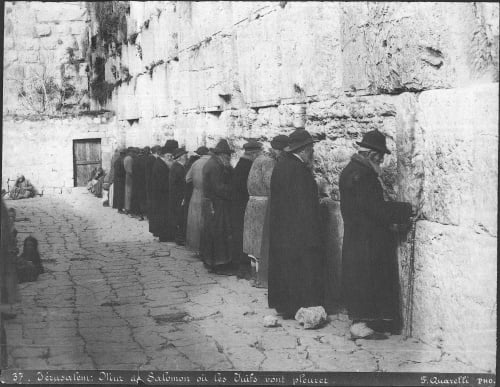
Basic History of the Kotel
The wall we call today the Western Wall, while not a part of the Holy Temple itself, was part of the Temple Mount retaining wall that Herod the Great built in the 1st century BCE when he ambitiously expanded the Temple Mount and renovated the then-dilapidated Second Temple.
When the Romans destroyed the Temple in 69 CE, this wall was not destroyed. And nearly two thousand years later, the wall still stands. Of the visible part of the wall, only the bottom seven layers of stones, consisting of large stones with indented borders, date from Herod's project. The next section, consisting of four layers of smaller, plainer stones, dates from the Byzantine period. The next layer up was added sometime after the Muslim conquest in the seventh century, and the topmost layer was added in the 19th century, paid for by the famed British philanthropist and financier, Sir Moses Montefiore.
Jews throughout the ages have visited the Western Wall to offer prayers at this holy location, because, our sages teach, the Shechinah (Divine Presence) that was manifest in the Temple never departed. Furthermore, access to the holiest site in the world, the Temple Mount itself, is prevented by the mainstream understanding of Jewish law, which forbids entry to the Temple site while in a state of ritual impurity. Thus the Western Wall constitutes the closest possible point to the "Gateway to Heaven."
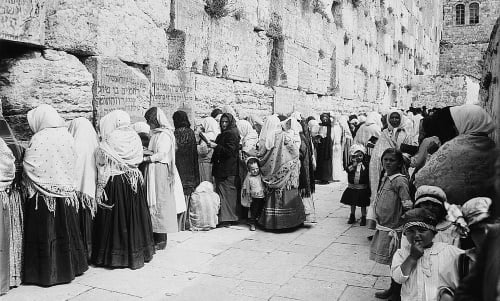
In the second half of the 16th century, Suleiman the Magnificent gave the Jews exclusive rights to worship at the Western Wall. The prayer area was small, closed off by a wall running parallel to the Wall and hemmed in by a slum area. It stayed that way until 1947.
In 1930, a British appointed commission sanctioned by the League of Nations reaffirmed the Jews' right to pray at the Wall—but severely limited the sort of religious objects that could be brought to the Wall, and prohibited the blowing of the shofar at the site.
Between 1948 and 1967, the Old City of Jerusalem was under Jordanian control and Jews were altogether banned from visiting the Wall. Israeli paratroopers liberated the Temple Mount on June 7th 1967, the third day of the Six Day War, marking a rare, euphoric moment in our nation's history. A few weeks later, on the holiday of Shavuot, a quarter of a million Jews streamed to the Wall.
Until then, the accessible portion of the Wall had been a 100 foot-long stretch of the massive wall, and the open area before the Wall was only ten feet wide. The many buildings in front of the wall were immediately razed, all the way to its southern corner. The entire area was leveled and paved, creating a large open plaza.
Today, the part of the Wall visible from the plaza is 187 feet long. The entire length of the Western Wall, however, is actually 1,600 feet long. The northern portion of the Wall is still hidden by buildings in the adjacent Muslim Quarter.
Seventeen more layers of Western Wall stones are buried under the ground. Due to many generations of destruction and rebuilding, city upon city, the ground level is now higher and the bottom part of the western side of the Temple Mount is buried.

The Kotel Today
Walking with throngs of people to the Wall, it is possible to feel like an anonymous person in an anonymous crowd. Paying a curious visit, it is possible to feel distant, like a tourist observing some other culture. But it is very possible that there will be a moment of presence, of sensation; like the Zohar says, a feeling of being held close by a benevolent parent. The Temple is the heart of the Jewish people, and as such, when standing at its foot it is easy to feel the pulse of the beating heart.
When visiting the wall it is important to respect the sanctity of the location. Modest attire should be worn, and no photography is allowed on Shabbat or Jewish holidays.
"One who sees the site of the Holy Temple should say, 'Our holy house, our glory, where our parents praised you has been consumed by fire, and all that is precious to us has been destroyed' (Isaiah 64:10), and tear his garments as a symbol of mourning" – Code of Jewish Law. So if visiting the Wall (after an absence of at least thirty days), it is advisable to take along a shirt or jacket that has already seen its best days.
(There are certain days when we don't rend our garments, such as Shabbat, Jewish holidays, Friday afternoons or Rosh Chodesh.)
The area directly in front of the Wall is a large outdoor synagogue, divided into a men's and women's section. At the entrance to the men's section there is a tefillin booth, manned by Chabad volunteers throughout the daytime hours. Make your visit to the holiest Jewish site a spiritual experience—donning tefillin will only take five minutes or so; a friendly volunteer will lead you through from start to finish.
When you approach the wall, take a moment to meditate and express your thoughts to the One whose presence pervades this holy site. There is an age-old custom to write your supplications on a note, and insert it into a crack in the wall.
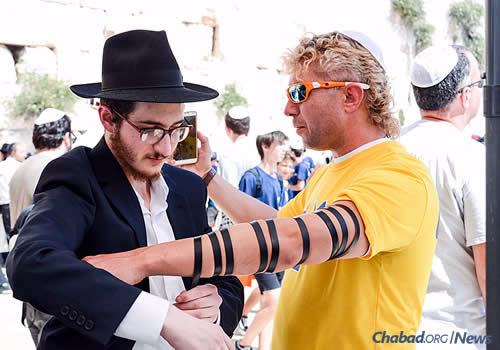
Ever since the Western Wall was liberated in 1967, archeological excavations have been ongoing beneath the Wall. While only a small section of the length of the wall is visible aboveground from the plaza, one can walk the entire length of the Wall in the underground tunnels and see all the subterranean layers of the wall, and even the bedrock beneath the wall. At the point directly opposite where the Holy of Holies once stood, there is an underground synagogue. These tunnels are an absolute must see! Touring these tunnels can only be done with a guide, and can be scheduled with the Western Wall Heritage Foundation (https://thekotel.org/en/tours/western-wall-tunnels).
Interesting Kotel Facts
- The Roman General Titus allowed the Western Wall to remain standing as a tribute to his power, a testament to the grandeur of the structures that he destroyed. While Titus may have had his reasons, G‑d had His own, too. Though He was about to subject His children to a long and harrowing exile, He desired that a remnant of the Temple remain intact—a holy place where we can gather and pray.
- Many of the Wall's subterranean stones uncovered by archeologists in the course of their excavations are extraordinarily large, bigger than any stone found in the pyramids. Some of the stones weigh hundreds of tons.
- The Western Wall is also known as the "Wailing Wall." This name was given by non-Jewish observers who were accustomed to see Jews gathering at the Wall and "wailing"; wailing in prayer, and wailing in mourning for the destroyed Holy Temples.
- Following basic training, many IDF combat units hold their swearing-in ceremonies at the Western Wall.
- Many people come from all parts of the world come to celebrate the bar and bat mitzvahs of their sons and daughters at the Western Wall.

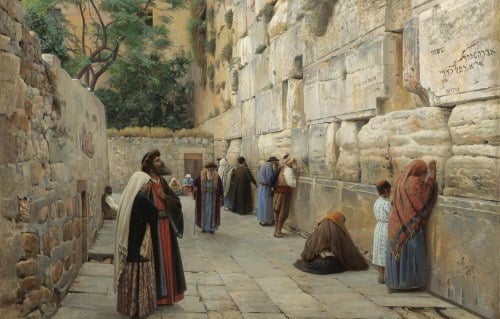



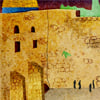

Join the Discussion